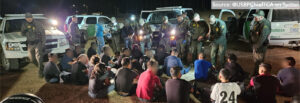Under the Trafficking Victims Protection Reauthorization Act of 2008 (TVPRA), when a Customs and Border Protection (CBP) agent apprehends unaccompanied minors from a non-neighboring country, they are automatically transferred to the Office of Refugee Resettlement (ORR). Here, they are screened for protection concerns, receive shelter, and are placed with a family member or sponsor while they await their immigration hearing.
In contrast, children from Mexico are denied this automatic placement with ORR and a court hearing. Under the TVPRA, instead of transferring Mexican children to ORR to be screened for protection concerns, a CBP agent conducts the screening interview. Before deporting Mexican children, the TVPRA requires agents to check that: 1) they aren’t victims of trafficking; 2) they don’t have a credible fear of returning home; and 3) they are able and willing to voluntarily return to Mexico. Back in Mexico, repatriated minors are received by the National Institute for Migration (Instituto Nacional de Migración, INM) and then placed in a children’s shelter under Mexico’s child and family services agency (Desarrollo Integral de la Familia, DIF).
In practice, this current system often fails to adequately screen and protect Mexican children fleeing violence. Below WOLA outlines recommendations for the U.S. and Mexican governments to improve screening and better protect vulnerable children.
Recommendations for the U.S. government:
- A governmental agency with expertise in child welfare and identifying victims of trafficking and persecution, such as the Office of Refugee Resettlement (ORR), should screen children for protection concerns, instead of CBP, a law enforcement agency.
- This would allow the screening interview to be conducted after the child has been transferred and settled with ORR, instead of immediately after apprehension by Border Patrol agents or at a port of entry, when the child is often exhausted, shocked, and confused.
- Outsourcing the responsibility of screening Mexican children to ORR would better ensure that all unaccompanied children in need of protection, regardless of their nationality, receive equal treatment and access to services and protections.
- If CBP agents are to continue in their role screening apprehended children they should be provided with additional training focused on child-appropriate custody care and how to screen for vulnerable children and victims of trafficking and persecution. Agents should be able to inform children of their rights and options in a language and manner they understand.
- CBP should establish and institutionalize screening and custody-care protocols that include guidelines on the conditions under which children are kept during detention, and the appropriate setting in which to conduct interviews, such as in a private, non-threatening environment.
- It must be ensured that there is proper oversight and accountability for agents who don’t follow protocol.
- Utilizing child welfare professionals trained in child-appropriate custody care and the identification of victims of trafficking and persecution would better ensure adequate screening and protections for migrant children.
- Child welfare professionals will free CBP agents of childcare and casework responsibilities and allow agents to focus on enforcement operations.
Recommendations for the Mexican government:
- Mexican authorities must take a more active role in screening repatriated children for protection concerns, examine the underlying reasons for why a child left home, and increase coordination among the different agencies responsible for these children.
- Authorities must not automatically assume that family reunification is in the child’s best interest and should establish guidelines for determining the child’s safest reintegration option.
- Programs providing social assistance, protective services, and home follow-up must be developed in order to ensure a full and smooth reintegration.
- Mexico’s federal and state governments should direct greater resources to violence prevention programs in order to expand and strengthen community-level programs for at-risk youth.
- Intervening with at-risk children through violence prevention programs, particularly in Mexican border cities where this dynamic is more prevalent, could help reduce the number of children recruited into criminal gangs and provide better alternatives for these young people in their home communities.
Recommendations for both governments:
- Upon repatriating a Mexican minor, U.S. officials should notify Mexican authorities of any information that may help them determine the safest option for the child’s reintegration.
- Mexican authorities should develop programs in coordination with U.S. authorities to intervene with niños de circuito, which prioritize the protection of young people who are forced to smuggle drugs and/or migrants, establish options for leaving the smuggling cycle, and support the safe reintegration of these repatriated at-risk minors.

